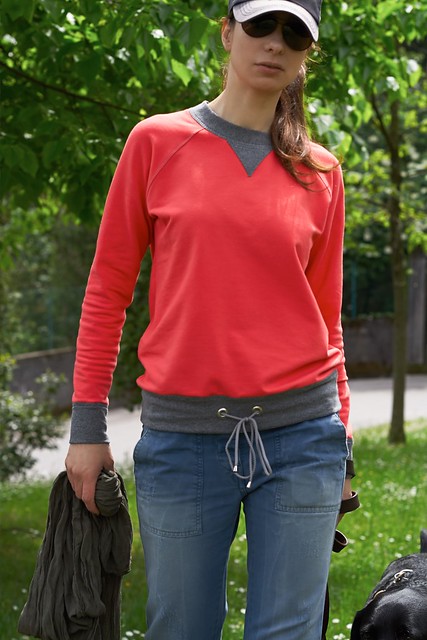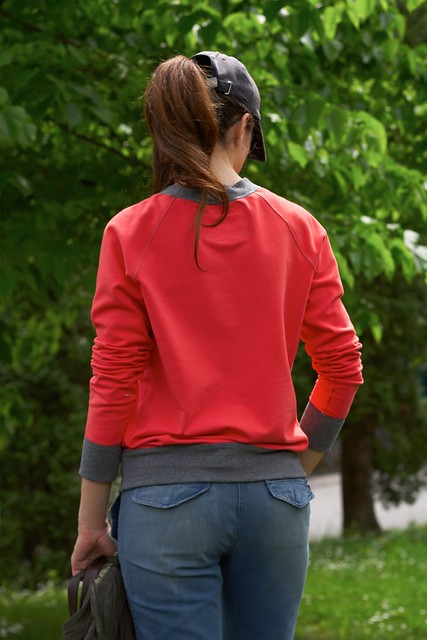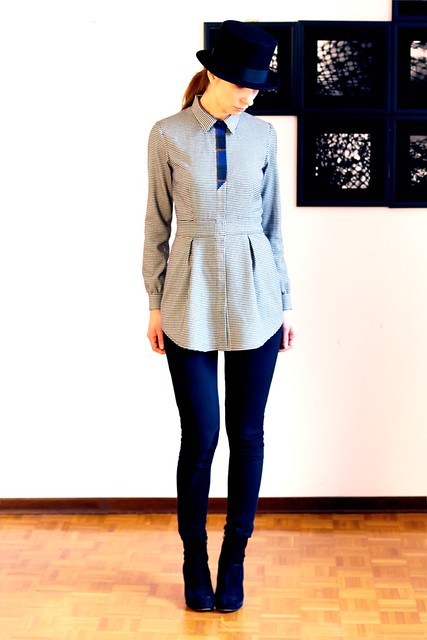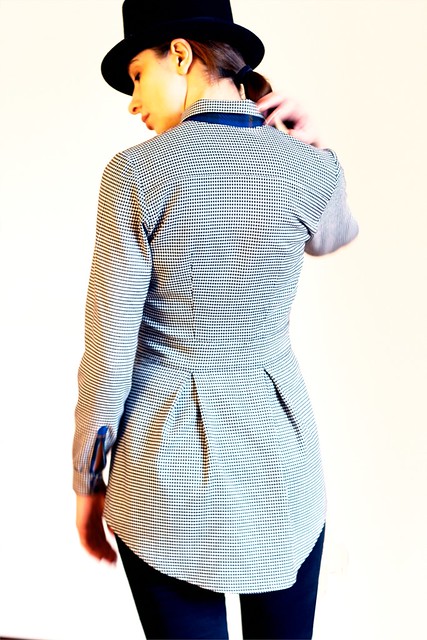Cos'è il neoprene comunque?
E’ una gomma sintetica. Nella sua forma colata è molto elastica mentre come schiuma laminata su maglia è un ottimo isolante. L'industria tessile impiega solitamente il neoprene laminato sopratutto nei spessori 1.5, 3 e 6mm: i più comunemente usati per l'abbigliamento/attrezzatura sportiva come le mute da sub. Visto che il mio fidanzato ne possiede un paio ho avuto la possibilità di guardare bene, tirare, piegare il tessuto/materiale e concluso che si mi piacerebbe una giacca. Con il campione da 3mm in mano ho preso a disegnarne una. Per sua natura il neoprene non si stira perciò niente riprese. Non volendo un taglio squadrato la scelta ovvia è stata il taglio princesse. Per appiattire le cuciture ho scelto di impuntare tutto … o comunque il possibile. Dato che era la prima volta che utilizzavo tale materiale, il piano era di provare a semplificare il più possibile le cose - evitare spessori eccessivi e niente chiusure o colletti complessi. La manica a due pezzi è stata l'eccezione forzata diciamo. Penso che un tessuto rigido richieda solitamente una manica a due pezzi. Finalmente ho scelto la silhouette impero ... perché è una tra le mie preferite.
Mi piace
Il colore ... questo verde acido è stato la ragione principale per la quale ho acquistato questo tessuto da
Supercut. Mi piace anche la silhouette - penso di aver trovato un buon rapporto tra sportivo e carino. Per finire permettetemi di darmi da sola una pacca sulla spalla per il progetto della manica. Questo è stato il mio primo progetto di manica a due pezzi e penso di aver fatto un ottimo lavoro - se posso dirlo.
Non mi piace
Non tutto il neoprene è uguale. Poco ne sapevo ma alcuni tessuti neoprene non sono neoprene ma sembrano neoprene. Questo qui è più un accoppiato in jersey. Forse il collante è uno strato sottilissimo di neoprene o forse qualcos’altro, non lo so. Il fatto è che che non c’è elasticità. Se lo si tira si può letteralmente sentire lo strato di collante crepare ed il tessuto subirà una deformazione permanente. E’ anche molto sottile quindi ho dovuto usare della fliselina per provare a irrigidirlo e stabilizzarlo … La ragione per la quale ho usato una fliselina elastica sinceramente mi sfugge … devo aver avuto spento il cervello. Per quel che riguarda l’isolamento … beh … non c’e isolamento. Il vento ci passa a traverso come se niente fosse. Per farla diventare un po più calda ho usato una fodera in pile … e visto che parliamo di pile perché non sbizzarrirsi con il colore!? In teoria utilizzare del pile all’interno è un’idea ok ma in questo caso e visto che il tessuto della scocca non è molto rigido, la fodera attaccandosi ai vestiti sotto interferisce con il drappeggio sopratutto in movimento.

In retrospettiva penso questo tessuto sarebbe stato meglio adatto per uno strato intermedio tipo un cardigan o qualcos’altro.
Le foto
Devo ammettere che per un pezzo ho preso in considerazione l’idea di smontare tutto riattaccare della fliselina rigida e rifoderare con un altro tipo di tessuto magari, ma in questo caso, nella mia personale battaglia interna tra DOC (intesso come disturbo ossessivo-compulsivo) e pigrizia ha vinto la pigrizia. Ho avuto anche un piccolo aiutino a decidere da parte di alcune tra le ragazze all’
Incontro di Cucito (a proposito, fantastica esperienza!!!) che mi hanno suggerito che sarebbe stato un lavoraccio con dubbi risultati poi. Nel fra tempo e negli ultimi due mesi all’incirca l’ho comunque indossata parecchio - è leggera, confortevole e facile da portare in giro sul treno per esempio - e la finestra che avevo per modificarla penso si sia chiusa. Forse un giorno quando sarò riuscita a mettere le mani su del neoprene neoprene come quello delle mute la rifarò semplicemente … o forse no.
Voi cosa fareste?
Come al solito includo il cartamodello che ho usato; come sempre per ragioni scientifiche. E’ la bozza (il draft) della scocca senza margini di cucitura. Usare con cautela … non è una misura standard ma è adattata al mio corpo. Potrà essere
scaricato fino alla pubblicazione del mio prossimo post - una settimana, un mese chissà … ultimamente sono stata super impegnata tra scuola, lavoro e vita in generale.
Ps. La sto ovviamente indossando con la salopette
Turia :)
Update: dettaglio della chiusura lampo su
Instagram















